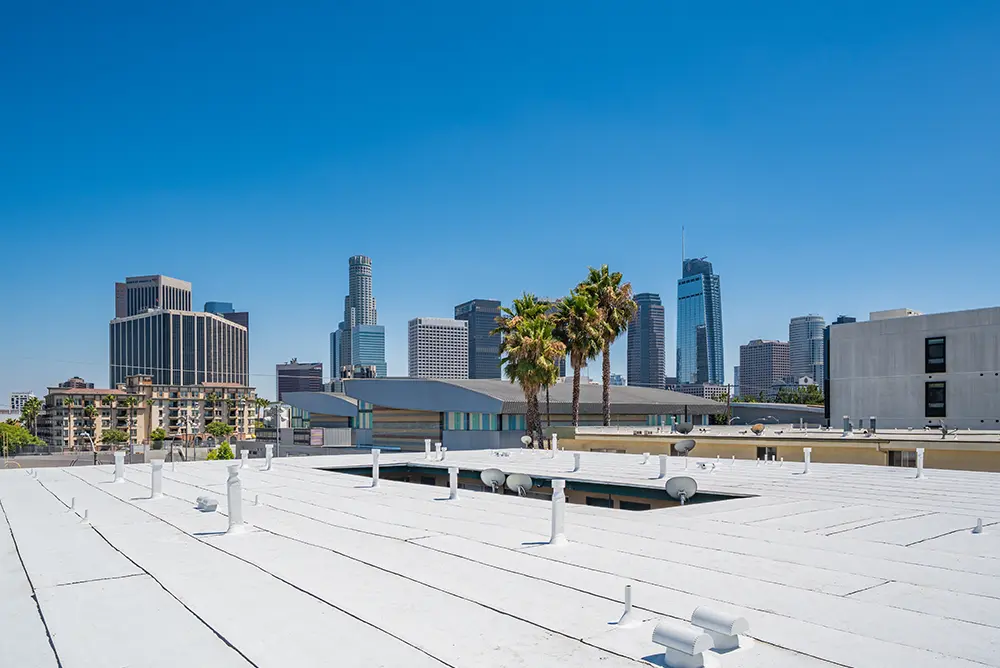In the competitive landscape of commercial real estate, the choice of roofing system can significantly impact a property’s value, maintenance costs, and energy efficiency. For business owners, landlords, property managers, and HOA property managers in Los Angeles, Ventura, and Orange Counties, understanding the various types of roofs available is crucial for making informed decisions. This article offers a comprehensive overview of different commercial roofing systems, including flat and pitched options, as well as the latest advancements in roofing materials. By equipping yourself with this knowledge, you can ensure that your investment not only meets regulatory standards but also enhances the longevity and performance of your building.
Characteristics of Commercial Flat Roofs
A commercial flat roof is a prevalent roofing style utilized in commercial buildings, characterized by its expansive, level surface designed to support various equipment, such as air conditioning units and boilers. These roofs are typically constructed from composite materials, which may include rubber, plastics, or oil-based products. Additionally, they are often finished with protective coatings, such as urethane or carbonate, to enhance durability and performance.
The Importance of Flat Roofs in Commercial Buildings
In Los Angeles, approximately 30% of the roofs are large commercial flat roofs. This statistic highlights the prevalence of flat roofing systems in the region, making it essential for business owners and property managers to understand their characteristics and benefits. Flat roofs offer several advantages, including easy installation, accessibility for maintenance, and the potential for improved energy efficiency when paired with suitable materials. As you consider roofing options for your commercial building, recognizing the significance of flat roofs in the local landscape can inform your decision-making process.
Exploring Pitched Roof Options for Commercial Buildings
Commercial roofs come in a variety of shapes, including pitched designs. Understanding these different configurations is essential for making informed decisions about roofing systems, as each type offers unique benefits and considerations. Pitched roofs, for example, can facilitate water drainage and reduce the risk of leaks, making them a popular choice for many commercial buildings. By exploring the available options, business owners and property managers can select the roofing solution that best meets their needs in terms of durability, maintenance, and energy efficiency.
Evolution of Commercial Roofing Materials
Before the 1980s, commercial roofing materials were predominantly asphalt-based. Today, this has shifted significantly, with asphalt now comprising only about 30% of roofing materials. The remaining 70% consists of various synthetic options, including plastics and rubber, which offer enhanced durability and performance. This evolution in materials reflects advancements in roofing technology, providing property owners with diverse choices that meet modern standards for energy efficiency and longevity.
Choosing the Right Roofing Material for Water Management
When selecting a roofing system for commercial buildings, one of the primary considerations is the material used, particularly in terms of water retention. For roofs designed to hold water, plastic materials are often the best choice due to their superior resistance to ponding issues. On the other hand, roofs equipped with effective drainage systems can support a wider variety of materials, including those composed of asphalt. Understanding these distinctions is crucial for making informed decisions about roofing options that align with your property’s specific needs.
Key Roofing Solutions for Commercial Buildings
SBR Roofing specializes in servicing a wide range of roofing systems, with particular expertise in single-ply roofing solutions and asphalt-based APP (Atactic Polypropylene) membranes. These systems are known for their durability, energy efficiency, and ease of maintenance, making them popular choices for commercial buildings. Understanding the unique characteristics and benefits of each roofing type is essential for property managers and business owners when selecting the right solution for their needs.
Conclusion
Selecting the right roofing system for your commercial building is a critical decision that can affect both immediate and long-term outcomes. With a variety of options available, including flat and pitched roofs, as well as advanced materials that cater to specific needs, such as water management, it is essential to consider factors like durability, maintenance, and energy efficiency. At SBR Roofing, we are committed to providing you with the expertise and quality artistry that has defined our sixty-year legacy in the industry. By understanding your roofing options, you can make an informed decision that aligns with your property’s needs and long-term objectives.







